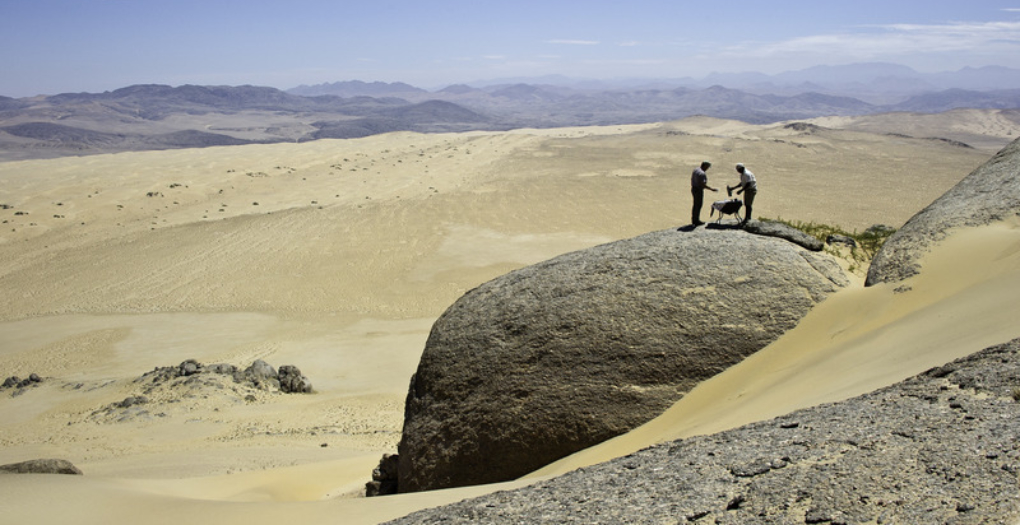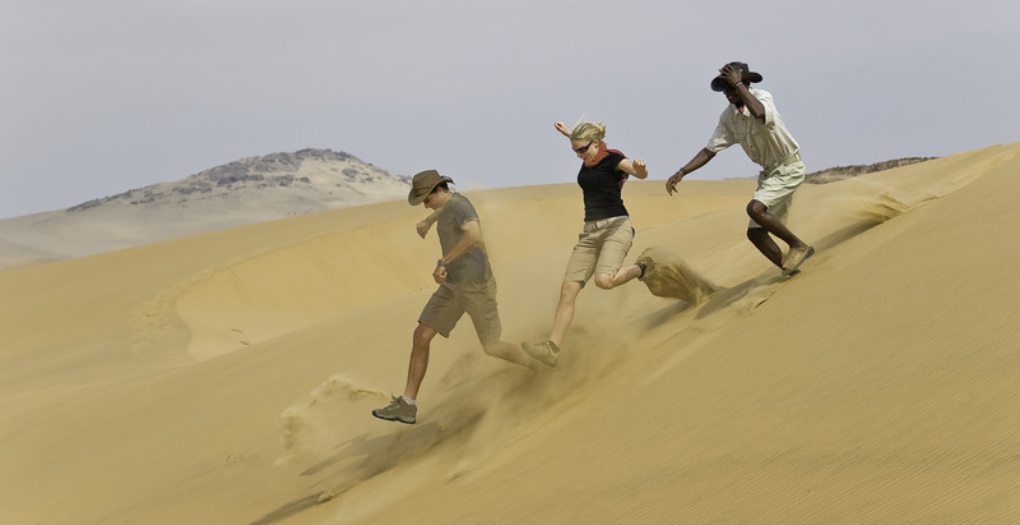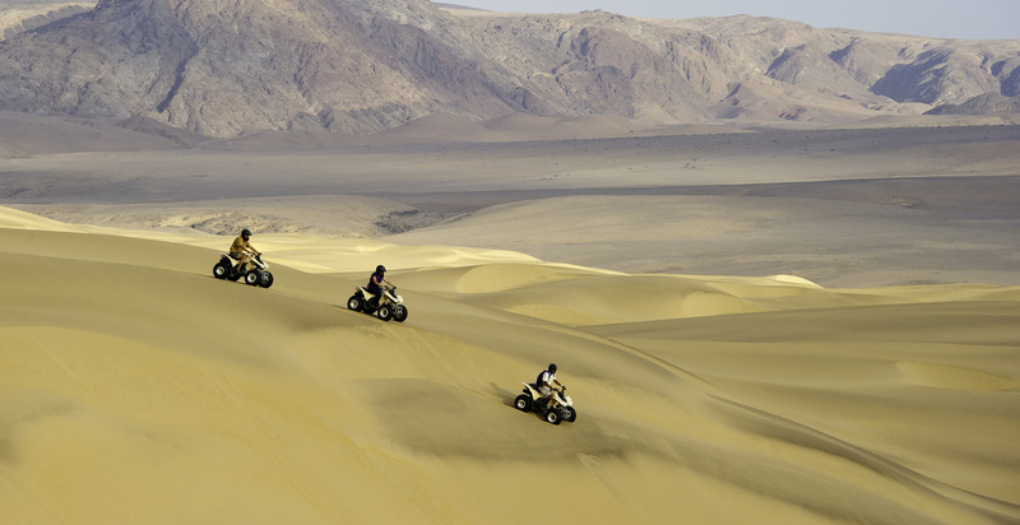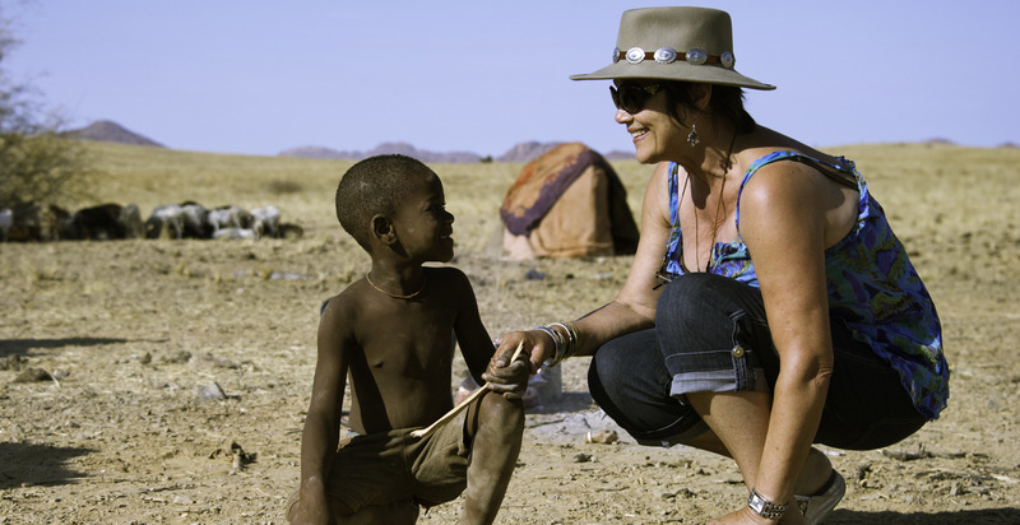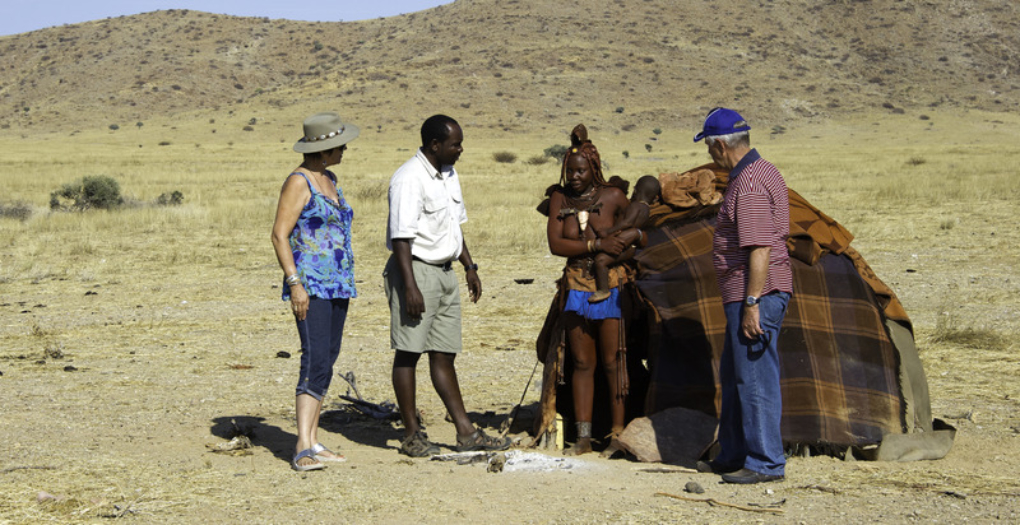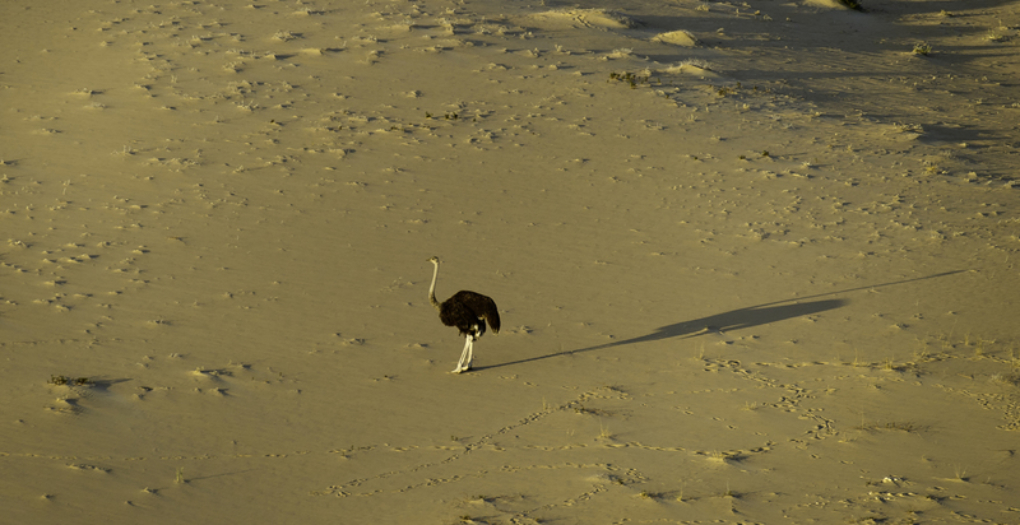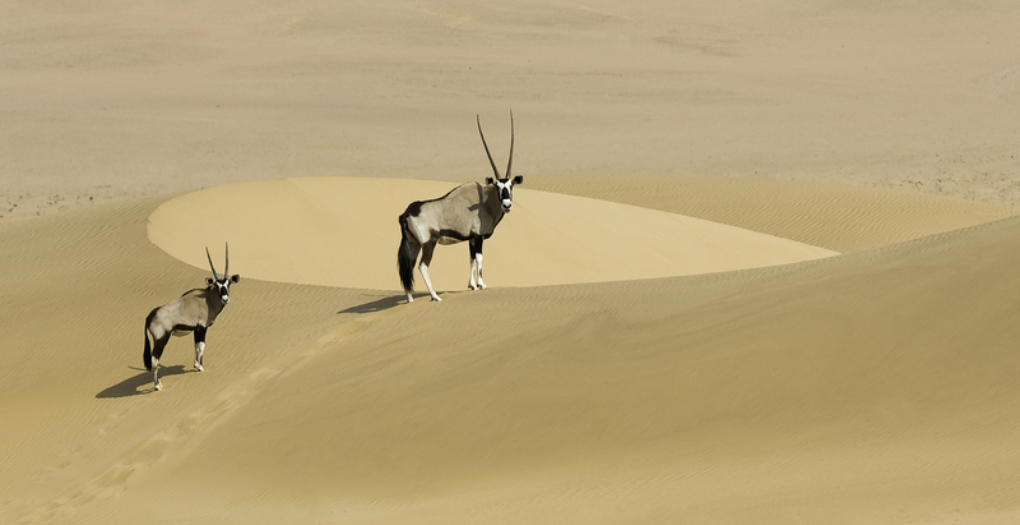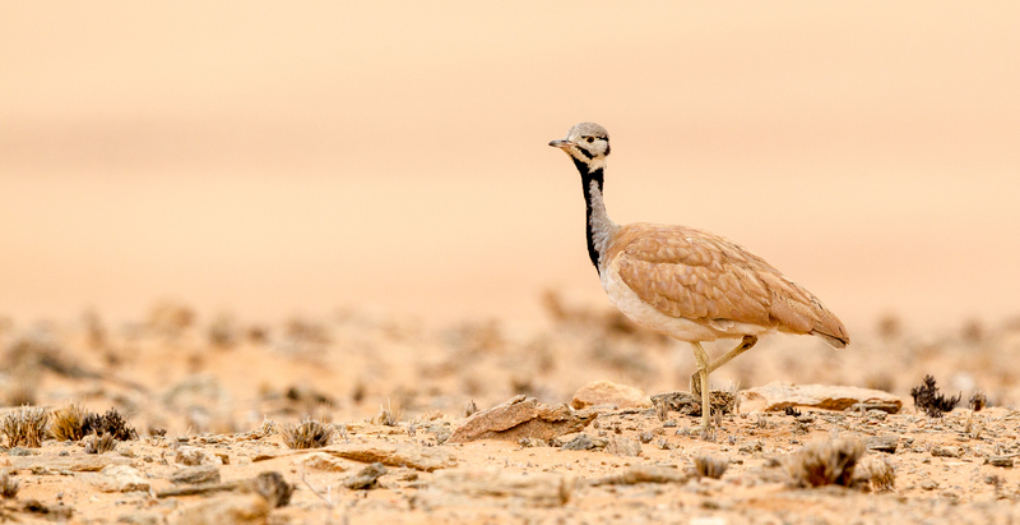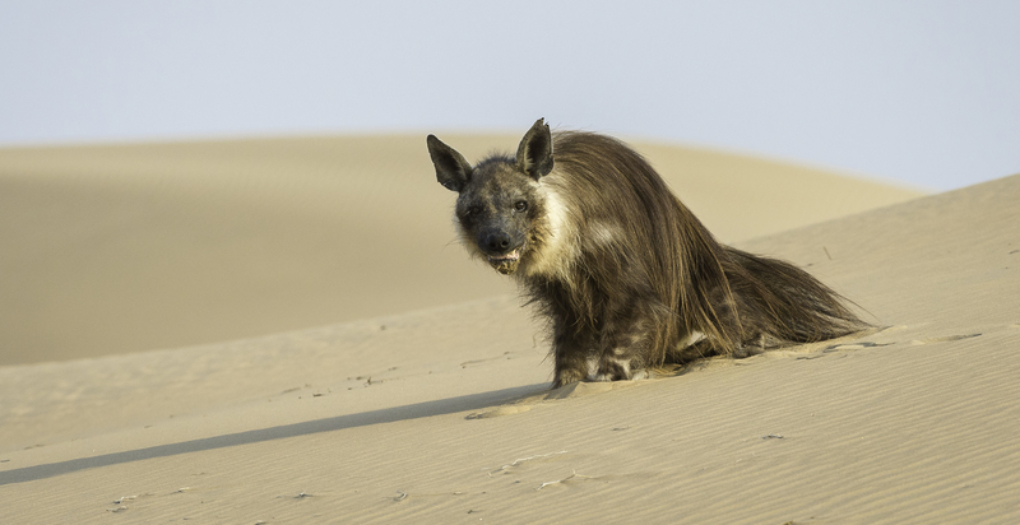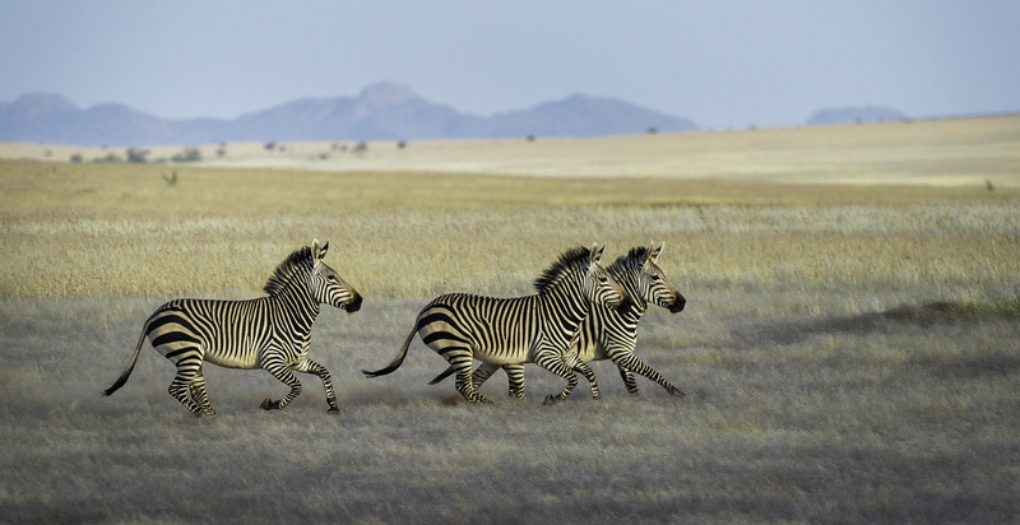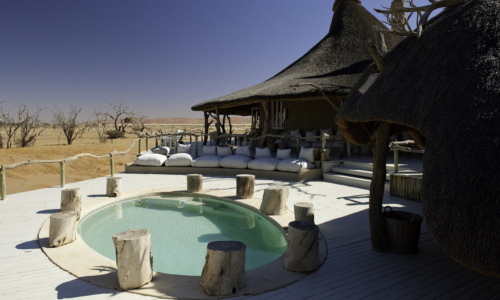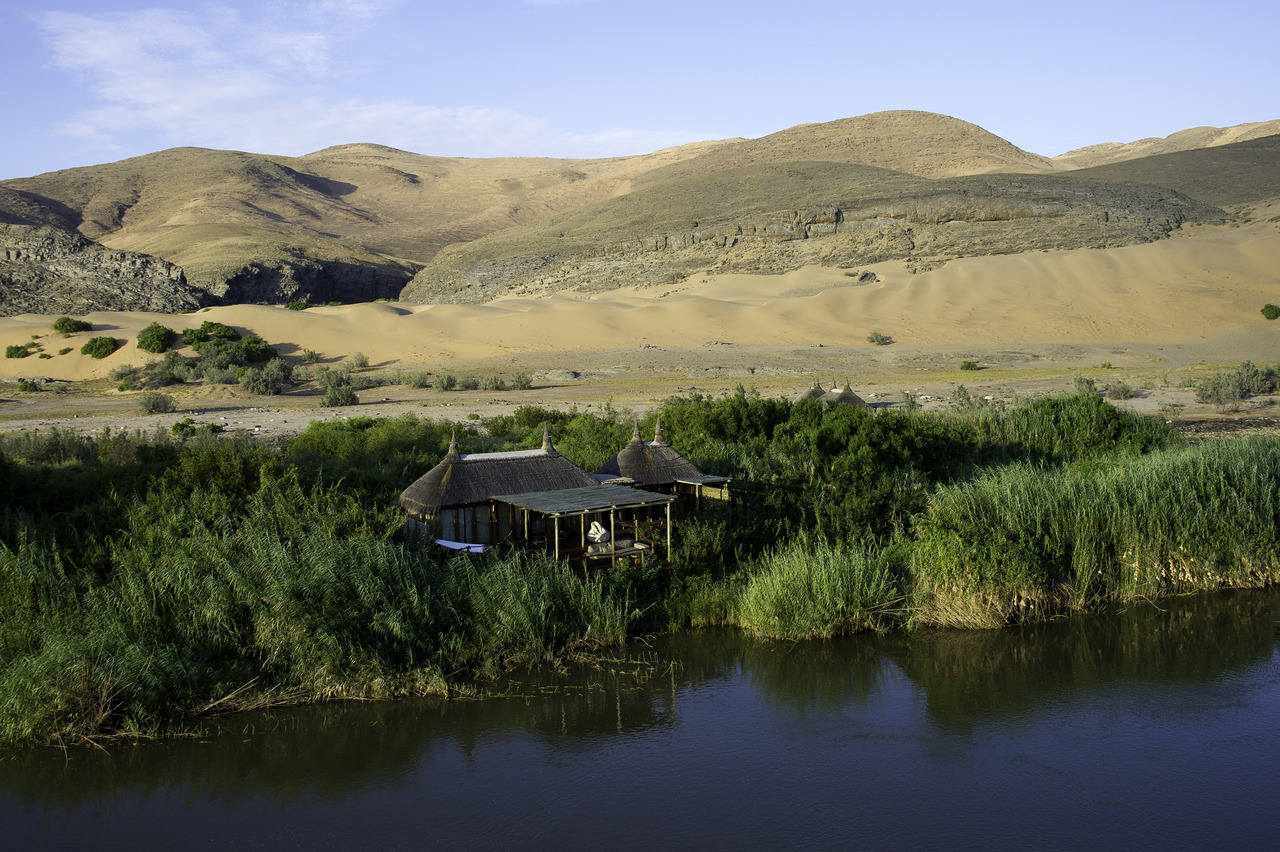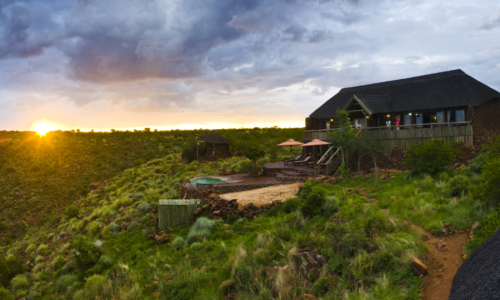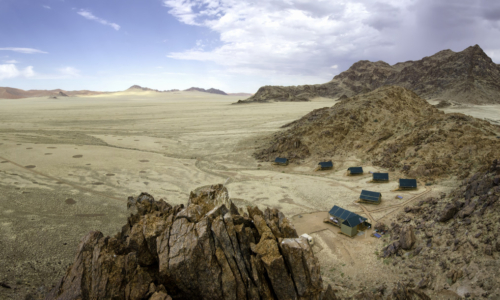Kaokoland occupies the vast wilderness between the Hoanib River to the Kunene River. The area is largely mountainous and includes the Baynes Moutains, Otjihipa Mountains, and Hartmann Mountains. The landscape is mainly rocky and barren. Yet there are swathes of green in the Marienfluss and Hartmann Valleys. As the only permeant water source in the region, the Kunene River and its verdant banks cuts a winding band of green through the lunar-like landscape of the Namib Desert which stretches to the Serra Cafema mountain range in the north. The Ovahimba people, a descendant of the Herero people, still retain much of their nomadic and pastoral life-style and account for a third of the population of Kaokoland.
Because of its arid conditions, there are fewer animals found here. Yet, the region is famous for its desert-adapted elephants. These hearty pachyderms only drink every three or four days and travel around thirty-seven miles per day in search of water and food. They are commonly fund roaming the dry riverbeds where they feed on the nutrient rich mopane bark, tamarisk, reeds, and the pods, bark, and leaves of the ana tree. When water is truly scarce, these resourceful animals will dig holes in the dry riverbeds bringing up water for themselves and other animals.
Other animals in the region include small herds of gemsbok, springbok, and Hartmann’s mountain zebra. The Kunene River even has a large population of Nile crocodiles. For bird lovers, Burchell’s courser and Benguela long-billed lark are some of the bird species to be found here. The black rhino was recently reintroduced to the area.
There are plenty of thrilling activities to be had in Kaokoland, with most centering on exploring the contrasting topography. Within the same day, one can cruise on the river observing the behavior of crocodiles and then traverse the sand dunes on a guided quad bike excursion. Informative nature drives in open Land Rovers explore the vast dunes of the Namib Desert. For a closer look, there are also nature walks with a knowledgeable guide. For a cultural tour, a visit to the local Ovahimba settlement is also a must. Instead of the traditional game drive, most excursions focus on tracking the elusive desert-adapted elephants. Kicking up the fun a notch, white water rafting and canoeing trips are available on the Kunene River.

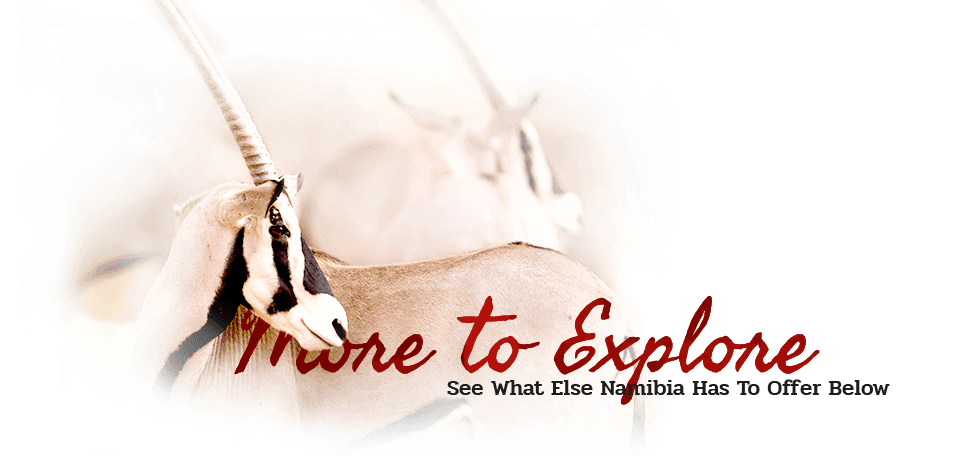
- Anderssons at Ongava
- Babson House
- Camp Kipwe
- Canyon Lodge
- Canyon Roadhouse
- Canyon Village
- Cape Cross Lodge
- Chobe Savanna Lodge
- Damara Mopane Lodge
- Damaraland Camp
- Dead Valley Lodge
- Desert Hills Glamping Camp
- Desert Homestead
- Desert Homestead Outpost
- Desert Rhino Camp
- Dolomite Camp
- Doro Nawas Camp
- Eagle’s Nest Lodge
- Erongo Wilderness Lodge
- Etosha Heights Safari House
- Etosha Mountain Lodge
- Etosha Safari Camp
- Etosha Safari Lodge
- Fish River Lodge
- Fort Sesfontein Lodge
- Grootberg Lodge
- Halali Camp
- Hoanib Elephant Camp
- Hoanib Skeleton Coast Camp
- Hoanib Valley Camp
- Ichingo Chobe River Lodge
- Kalahari Anib Lodge
- Kalahari Farmhouse
- Khorixas Rest Camp
- Kulala Desert Lodge
- Kwessi Dunes
- Little Kulala
- Little Ongava
- Malansrus Tented Camp
- Mowani Mountain Camp
- Mushara Bush Camp
- Mushara Lodge
- Mushara Outpost
- Naankuse Lodge
- Namib Desert Lodge
- Namushasha River Lodge
- Namutoni Camp
- Nhoma Safari Camp
- Nkasa Linyanti
- Okahirongo Elephant Lodge
- Okahirongo River Camp
- Okaukuejo Camp
- Okonjima Bush Camp
- Okonjima Bush Suite
- Okonjima Grand African Villa
- Okonjima Plains Camp
- Onduli Ridge
- Ongava Lodge
- Ongava Tented Camp
- Onguma Bush Camp
- Onguma Etosha Aoba Lodge
- Onguma Tented Camp
- Onguma The Fort
- Onguma Tree Top Camp
- Onkoshi Camp
- Ozondjou Trails
- Popa Falls Camp
- River Crossing Lodge
- Safarihoek Lodge
- Serra Cafema Camp
- Shipwreck Lodge
- Sossus Dune Lodge
- Sossusvlei Desert Lodge
- Terrace Bay Camp
- Teufelskrallen Tented Lodge
- Villa Mushara
- Wolwedans Boulders Camp
- Wolwedans Desert Lodge
- Wolwedans Dune Camp
- Wolwedans Mountain View Suite
- Wolwedans Plains Camp
- Anderssons at Ongava
- Babson House
- Camp Kipwe
- Canyon Lodge
- Canyon Roadhouse
- Canyon Village
- Cape Cross Lodge
- Chobe Savanna Lodge
- Damara Mopane Lodge
- Damaraland Camp
- Dead Valley Lodge
- Desert Hills Glamping Camp
- Desert Homestead
- Desert Homestead Outpost
- Desert Rhino Camp
- Dolomite Camp
- Doro Nawas Camp
- Eagle’s Nest Lodge
- Erongo Wilderness Lodge
- Etosha Heights Safari House
- Etosha Mountain Lodge
- Etosha Safari Camp
- Etosha Safari Lodge
- Fish River Lodge
- Fort Sesfontein Lodge
- Grootberg Lodge
- Halali Camp
- Hoanib Elephant Camp
- Hoanib Skeleton Coast Camp
- Hoanib Valley Camp
- Ichingo Chobe River Lodge
- Kalahari Anib Lodge
- Kalahari Farmhouse
- Khorixas Rest Camp
- Kulala Desert Lodge
- Kwessi Dunes
- Little Kulala
- Little Ongava
- Malansrus Tented Camp
- Mowani Mountain Camp
- Mushara Bush Camp
- Mushara Lodge
- Mushara Outpost
- Naankuse Lodge
- Namib Desert Lodge
- Namushasha River Lodge
- Namutoni Camp
- Nhoma Safari Camp
- Nkasa Linyanti
- Okahirongo Elephant Lodge
- Okahirongo River Camp
- Okaukuejo Camp
- Okonjima Bush Camp
- Okonjima Bush Suite
- Okonjima Grand African Villa
- Okonjima Plains Camp
- Onduli Ridge
- Ongava Lodge
- Ongava Tented Camp
- Onguma Bush Camp
- Onguma Etosha Aoba Lodge
- Onguma Tented Camp
- Onguma The Fort
- Onguma Tree Top Camp
- Onkoshi Camp
- Ozondjou Trails
- Popa Falls Camp
- River Crossing Lodge
- Safarihoek Lodge
- Serra Cafema Camp
- Shipwreck Lodge
- Sossus Dune Lodge
- Sossusvlei Desert Lodge
- Terrace Bay Camp
- Teufelskrallen Tented Lodge
- Villa Mushara
- Wolwedans Boulders Camp
- Wolwedans Desert Lodge
- Wolwedans Dune Camp
- Wolwedans Mountain View Suite
- Wolwedans Plains Camp

Kaokoland occupies the vast wilderness between the Hoanib River to the Kunene River. The area is largely mountainous and includes the Baynes Moutains, Otjihipa Mountains, and Hartmann Mountains. The landscape is mainly rocky and barren. Yet there are swathes of green in the Marienfluss and Hartmann Valleys. As the only permeant water source in the region, the Kunene River and its verdant banks cuts a winding band of green through the lunar-like landscape of the Namib Desert which stretches to the Serra Cafema mountain range in the north. The Ovahimba people, a descendant of the Herero people, still retain much of their nomadic and pastoral life-style and account for a third of the population of Kaokoland.
Because of its arid conditions, there are fewer animals found here. Yet, the region is famous for its desert-adapted elephants. These hearty pachyderms only drink every three or four days and travel around thirty-seven miles per day in search of water and food. They are commonly fund roaming the dry riverbeds where they feed on the nutrient rich mopane bark, tamarisk, reeds, and the pods, bark, and leaves of the ana tree. When water is truly scarce, these resourceful animals will dig holes in the dry riverbeds bringing up water for themselves and other animals.
Other animals in the region include small herds of gemsbok, springbok, and Hartmann’s mountain zebra. The Kunene River even has a large population of Nile crocodiles. For bird lovers, Burchell’s courser and Benguela long-billed lark are some of the bird species to be found here. The black rhino was recently reintroduced to the area.
There are plenty of thrilling activities to be had in Kaokoland, with most centering on exploring the contrasting topography. Within the same day, one can cruise on the river observing the behavior of crocodiles and then traverse the sand dunes on a guided quad bike excursion. Informative nature drives in open Land Rovers explore the vast dunes of the Namib Desert. For a closer look, there are also nature walks with a knowledgeable guide. For a cultural tour, a visit to the local Ovahimba settlement is also a must. Instead of the traditional game drive, most excursions focus on tracking the elusive desert-adapted elephants. Kicking up the fun a notch, white water rafting and canoeing trips are available on the Kunene River.

- Anderssons at Ongava
- Babson House
- Camp Kipwe
- Canyon Lodge
- Canyon Roadhouse
- Canyon Village
- Cape Cross Lodge
- Chobe Savanna Lodge
- Damara Mopane Lodge
- Damaraland Camp
- Dead Valley Lodge
- Desert Hills Glamping Camp
- Desert Homestead
- Desert Homestead Outpost
- Desert Rhino Camp
- Dolomite Camp
- Doro Nawas Camp
- Eagle’s Nest Lodge
- Erongo Wilderness Lodge
- Etosha Heights Safari House
- Etosha Mountain Lodge
- Etosha Safari Camp
- Etosha Safari Lodge
- Fish River Lodge
- Fort Sesfontein Lodge
- Grootberg Lodge
- Halali Camp
- Hoanib Elephant Camp
- Hoanib Skeleton Coast Camp
- Hoanib Valley Camp
- Ichingo Chobe River Lodge
- Kalahari Anib Lodge
- Kalahari Farmhouse
- Khorixas Rest Camp
- Kulala Desert Lodge
- Kwessi Dunes
- Little Kulala
- Little Ongava
- Malansrus Tented Camp
- Mowani Mountain Camp
- Mushara Bush Camp
- Mushara Lodge
- Mushara Outpost
- Naankuse Lodge
- Namib Desert Lodge
- Namushasha River Lodge
- Namutoni Camp
- Nhoma Safari Camp
- Nkasa Linyanti
- Okahirongo Elephant Lodge
- Okahirongo River Camp
- Okaukuejo Camp
- Okonjima Bush Camp
- Okonjima Bush Suite
- Okonjima Grand African Villa
- Okonjima Plains Camp
- Onduli Ridge
- Ongava Lodge
- Ongava Tented Camp
- Onguma Bush Camp
- Onguma Etosha Aoba Lodge
- Onguma Tented Camp
- Onguma The Fort
- Onguma Tree Top Camp
- Onkoshi Camp
- Ozondjou Trails
- Popa Falls Camp
- River Crossing Lodge
- Safarihoek Lodge
- Serra Cafema Camp
- Shipwreck Lodge
- Sossus Dune Lodge
- Sossusvlei Desert Lodge
- Terrace Bay Camp
- Teufelskrallen Tented Lodge
- Villa Mushara
- Wolwedans Boulders Camp
- Wolwedans Desert Lodge
- Wolwedans Dune Camp
- Wolwedans Mountain View Suite
- Wolwedans Plains Camp
- Anderssons at Ongava
- Babson House
- Camp Kipwe
- Canyon Lodge
- Canyon Roadhouse
- Canyon Village
- Cape Cross Lodge
- Chobe Savanna Lodge
- Damara Mopane Lodge
- Damaraland Camp
- Dead Valley Lodge
- Desert Hills Glamping Camp
- Desert Homestead
- Desert Homestead Outpost
- Desert Rhino Camp
- Dolomite Camp
- Doro Nawas Camp
- Eagle’s Nest Lodge
- Erongo Wilderness Lodge
- Etosha Heights Safari House
- Etosha Mountain Lodge
- Etosha Safari Camp
- Etosha Safari Lodge
- Fish River Lodge
- Fort Sesfontein Lodge
- Grootberg Lodge
- Halali Camp
- Hoanib Elephant Camp
- Hoanib Skeleton Coast Camp
- Hoanib Valley Camp
- Ichingo Chobe River Lodge
- Kalahari Anib Lodge
- Kalahari Farmhouse
- Khorixas Rest Camp
- Kulala Desert Lodge
- Kwessi Dunes
- Little Kulala
- Little Ongava
- Malansrus Tented Camp
- Mowani Mountain Camp
- Mushara Bush Camp
- Mushara Lodge
- Mushara Outpost
- Naankuse Lodge
- Namib Desert Lodge
- Namushasha River Lodge
- Namutoni Camp
- Nhoma Safari Camp
- Nkasa Linyanti
- Okahirongo Elephant Lodge
- Okahirongo River Camp
- Okaukuejo Camp
- Okonjima Bush Camp
- Okonjima Bush Suite
- Okonjima Grand African Villa
- Okonjima Plains Camp
- Onduli Ridge
- Ongava Lodge
- Ongava Tented Camp
- Onguma Bush Camp
- Onguma Etosha Aoba Lodge
- Onguma Tented Camp
- Onguma The Fort
- Onguma Tree Top Camp
- Onkoshi Camp
- Ozondjou Trails
- Popa Falls Camp
- River Crossing Lodge
- Safarihoek Lodge
- Serra Cafema Camp
- Shipwreck Lodge
- Sossus Dune Lodge
- Sossusvlei Desert Lodge
- Terrace Bay Camp
- Teufelskrallen Tented Lodge
- Villa Mushara
- Wolwedans Boulders Camp
- Wolwedans Desert Lodge
- Wolwedans Dune Camp
- Wolwedans Mountain View Suite
- Wolwedans Plains Camp








